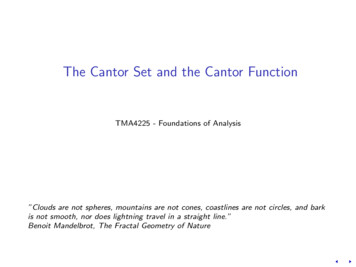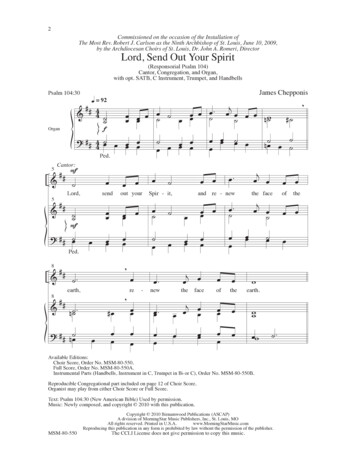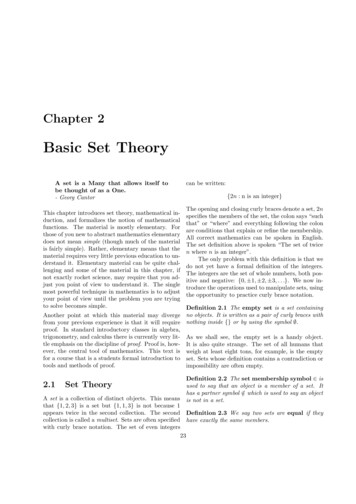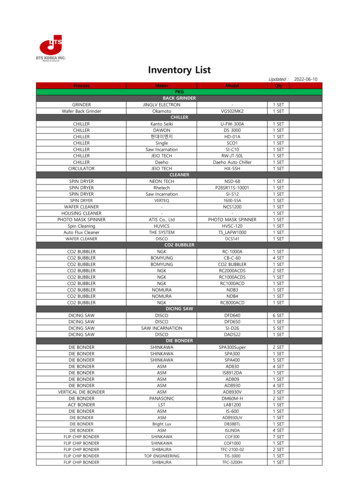
Transcription
The Cantor Set and the Cantor FunctionTMA4225 - Foundations of Analysis”Clouds are not spheres, mountains are not cones, coastlines are not circles, and barkis not smooth, nor does lightning travel in a straight line.”Benoit Mandelbrot, The Fractal Geometry of Nature
Definition of Cantor’s SetStep 0: we begin with the interval [0, 1].01Step 1: we divide [0, 1] into 3 subintervals and delete theopen middle subinterval ( 13 , 32 ).01 32 31Step 2: we divide each of the 2 resulting intervals above into3 subintervals and delete the open middle subintervals ( 91 , 29 )and ( 79 , 98 ).01 92 91/32/37 98 91We continue this procedure indefinitely. At each step, we deletethe open middle third subinterval of each interval obtained in theprevious step.
Definition of Cantor’s SetStep 0Step 1Step 2Step 3Step 4Step 5Step 6Cantor’s set is the set C left after this procedure of deleting theopen middle third subinterval is performed infinitely many times.Is there anything left?Yes, at least the endpoints of the deleted middle third subintervals.There are countably many such points.Are there any other points left?Yes, in some sense, a whole lot more. But in some other sense,just some dust - which in some ways is scattered, in some otherways it is bound together.We will describe different ways to ”measure” the dust left. Thiswill take us through several mathematical disciplines: set theory,measure theory, topology, geometric measure theory, real analysis.
Ternary Representation of Cantor’s SetEvery real number can be represented by an infinite sequenceof digits:1 0.33333 . . .3golden ratio 1.6180339887498948482045 . . .1 0.10000 . . . 0.09999 . . .10This is the decimal (base 10) representation: Numbers described using powers of 10 and Digits used: 0, 1, 2, 3, 4, 5, 6, 7, 8, 9 Some numbers can be represented in two ways, with onerepresentation having only 9’s from some point on.Computers use the binary (base 2) representation: everynumber is described using powers of 2 and digits 0, 1.golden ratio 1.100111100011011101111 . . .(2)1 0.1000 . . . 0.011111 . . .(2)2
Ternary Representation of Cantor’s SetWe can represent real numbers in any base. We will use theternary (base 3) representation, because Cantor’s set has a specialrepresentation in base 3.13237989 1 · 3 1 0.10000 . . .(3) 0.022222 . . .(3) 2 · 3 1 0.20000 . . .(3) 2 · 3 1 1 · 3 2 0.210000 . . .(3) 0.20222 . . .(3) 2 · 3 1 2 · 3 2 0.220000 . . .(3)A number is in Cantor’s set if and only if its ternary representationcontains only the digits 0 and 2 (in other words, it has no 1’s).C {x [0, 1] : x 0.c1 c2 c3 . . . cn . . .(3) where cn 0 or 2}
Set Theory ; Cantor’s set is uncountableWe already know that Cantor’s set is infinite: it contains allendpoints of deleted intervals. There are only countably manysuch endpoints.We will show that in fact Cantor’s set has a much larger cardinality(i.e. ”number” of elements).Theorem: The cardinality of Cantor’s set is the continuum.That is, Cantor’s set has the same cardinality as the interval [0, 1].Proof.The function f : C [0, 1] defined by:f (0.c1 c2 c3 . . . cn . . .(3) ) : 0.c1 c2 c3cn. . . . . . (2)2 2 22is onto, so card C card [0, 1].But clearly card C card [0, 1].Then card C card [0, 1] by Cantor-Bernstein-Schroedertheorem.
Measure Theory ; Cantor’s set is negligibleOne way to measure Cantor’s set (by ”counting” its elements)shows that it is a very large set - as large as the whole intervalit is part of.Another way to measure it is by looking at the amount ofspace it occupies on the line.Theorem: Cantor’s set is negligible.In other words, its ”length”/ Lebesgue measure is 0.Proof.Cantor’s set is obtained by successively removing intervals.We will measure the intervals removed.At each step the number of intervals doubles and their lengthdecreases by 3.
Measure Theory ; Cantor’s set is negligibleTotal length / measure of intervals removed: X1111 2 · 2 22 · 3 . . . 2n · n 1 . . . 13333n 0”Length” / measure of Cantor’s set 1 1 0.
Topology ; Structure of Cantor’s setTheorem: Cantor’s set has no interior points / it is nowhere dense.In other words, it is just ”dust”.That’s because its length is 0, so it contains no continuous parts(no intervals).Theorem: Cantor’s set is bounded.That’s because it lives inside the interval [0, 1].Theorem: Cantor’s set is closed.That’s because it is the complement relative to [0, 1] of openintervals, the ones removed in its construction.; Bounded Closed on the real line compact set(Heine-Borel theorem)Morally compact means that every task that may theoreticallyrequire an infinite number of steps/infinite amount of data, can beaccomplished in a finite number of steps /with finite resources.
Topology ; Structure of Cantor’s setTheorem: Cantor’s set has no isolated points.That is, in any neighborhood of a point in Cantors’s set, there isanother point from Cantor’s set.”Proof.” Given say a 0.0220020202 . . .(3) C one could findanother element b 0.0220022202 . . .(3) C which is near a. ; In topology, a set which is compact and has no isolated pointsis called a perfect setTheorem: Cantor’s set is totally disconnected.In other words, given any two elements a, b C , Cantor’s set canbe divided into two disjoint and closed neighborhoods A and B,one containing a and the other containing b.”Proof.” Given say the numbers a and b from above:Neighborhood A all elements of C whose 7th digit is 0.Neighborhood B all elements of C whose 7th digit is 2.
Geometric Measure Theory ; Cantor’s Set is a FractalTheorem: Cantor’s set is self-similar.More accurately: magnify Cantor’s set by 3, get 2 copies of itself.
Back to Real Analysis ; Cantor’s FunctionThe function defined earlier, f : C [0, 1]f (0.c1 c2 c3 . . . cn . . .(3) ) : 0.cnc1 c2 c3. . . . . .(2)2 2 22has the following properties:It is onto.It is increasingIt is not one to one. For instance:11f ( ) f (0.0222 . . .(3) ) 0.01111 . . .(2) 0.1(2) 3221f ( ) f (0.2000 . . .(3) ) 0.10000 . . .(2) 0.1(2) 32Two inputs of f have the same outputs if and only if they arethe endpoints of an interval removed - like ( 13 , 23 ) or ( 19 , 29 ) etc.
Back to Real Analysis ; Cantor’s FunctionExtend f to the whole interval [0, 1] by making it constant onthese removed intervals.The function obtained by this extension is called Cantor’s function.1Devil's Staircase34121401212789933991 Cantor’s function is onto. Cantor’s function is increasing, but constant almosteverywhere (except on the ”dust”). Cantor’s function is continuous. The derivative of Cantor’s function is 0 almost everywhere.
The Devil’s Staircase .134121401212789933991
. and Its Musical CounterpartCantor’s function, also called the Devil’s Staircase, makes acontinuous finite ascent (from 0 to 1) in an infinite number ofsteps (there are infinitely many intervals removed) whilestaying constant most of the time.Playing the following YouTube video (click the link):http://youtu.be/1ZTaiDHqs5s?t 8syou will hear the musical illustration of this ascent (followedby a descent and by more playing along the staircase). It iscalled ”L’Escalier du Diable” (i.e. ”The Devil’s Staircase”). Itwas composed in the 90’s by the composer György Ligeti.This composition is harmonically self-similar, like Cantor’s set.Its structure has the musical equivalent of dividing an intervalinto three parts, changing the middle, repeating the processand matching the pitch arrangements to this structure, justlike with Cantor’s set and function.But unlike its mathematical counterpart, the process is finite,its infinity being only suggested.
Theorem: Cantor's set has no isolated points. That is, inany neighborhoodof a point in Cantors's set, there is anotherpoint from Cantor's set. "Proof."Given say a 0:0220020202::: (3) 2C one could nd anotherelement b 0:0220022202::: (3) 2C which is near a.; In topology, a set which is compact and has no isolated points is called a .










